ARDS NCLEX Guías de estudio, Notas de estudios & Resúmenes
¿Buscas las mejores guías de estudio, notas de estudio y resúmenes para ARDS NCLEX? En esta página encontrarás 61 documentos de estudio para ARDS NCLEX.
Página 2 fuera de 61 resultados
Ordenador por
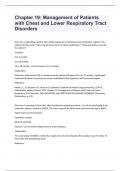
-
Chapter 19: Management of Patients with Chest and Lower Respiratory Tract Disorders fully solved 2024
- Examen • 63 páginas • 2024
-
Disponible en paquete
-
- 19,17 €
- + aprende más y mejor
Chapter 19: Management of Patients with Chest and Lower Respiratory Tract DisordersThe nurse is educating a patient who will be started on an antituberculosis medication regimen. The patient asks the nurse, "How long will I have to be on these medications?" What should the nurse tell the patient? 3 months 3 to 5 months 6 to 12 months 13 to 18 months - correct answer 6 to 12 months Explanation: Pulmonary tuberculosis (TB) is treated primarily with anti-TB agents for 6 to 12 months. A prol...
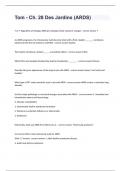
-
Tom - Ch. 28 Des Jardins (ARDS) correctly answered 2024
- Examen • 9 páginas • 2024
-
Disponible en paquete
-
- 12,46 €
- + aprende más y mejor
Tom - Ch. 28 Des Jardins (ARDS)T or F: Regardless of etiology, ARDS pts undergo similar anatomic changes - correct answer T As ARDS progresses, the intraalveolar walls become lined with a thick, rippled _______ membrane identical to the that of newborns with RDS - correct answer Hyaline The hyaline membrane contains _____ and cellular debris - correct answer Fibrin When fibrin and exudate develop they lead to intraalveolar _______. - correct answer Fibrosis Describe the gross appeara...
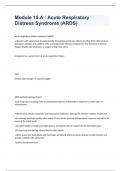
-
Module 15.A : Acute Respiratory Distress Syndrome (ARDS) well solved 2024
- Examen • 6 páginas • 2024
-
Disponible en paquete
-
- 12,46 €
- + aprende más y mejor
Module 15.A : Acute Respiratory Distress Syndrome (ARDS)acute respiratory distress syndrome (ARDS) a disorder with rapid onset characterized by noncardiac pulmonary edema resulting from inflammatory damage to alveolar and capillary walls, and progressive refractory hypoxemia (the decrease of arterial oxygen despite administration of oxygen at high flow rates) recognized as a severe form of acute respiratory failure FiO2 fraction (percentage) of inspired oxygen ARDS pathophys...
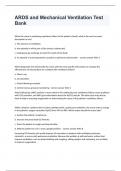
-
ARDS and Mechanical Ventilation Test Bank verified already passed
- Examen • 27 páginas • 2024
-
Disponible en paquete
-
- 17,25 €
- + aprende más y mejor
ARDS and Mechanical Ventilation Test BankWhen the nurse is explaining respiratory failure to the patient's family, what is the most accurate description to use? a. The absence of ventilation. b. Any episode in which part of the airway is obstructed. c. Inadequate gas exchange to meet the needs of the body. d. An episode of acute hypoxemia caused by a pulmonary dysfunction. - correct answer ANS: C Which diagnostic test will provide the nurse with the most specific information to evaluate ...
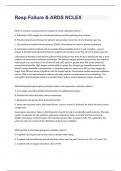
-
Resp Failure & ARDS NCLEX correctly answered rated A+
- Examen • 8 páginas • 2024
-
Disponible en paquete
-
- 12,46 €
- + aprende más y mejor
Resp Failure & ARDS NCLEXWhich is a proper nursing action for a patient in acute respiratory failure? A. Administer 100% oxygen to an intubated patient until the pathology has resolved. B. Provide chest physical therapy for patients who produce more than 30 mL of sputum per day. C. Use continuous positive airway pressure (CPAP) if the patient has weak or absent respirations. D. Administer packed red blood cells to maintain the hemoglobin level at 7 g/dL or higher. - correct answer B. Provide...
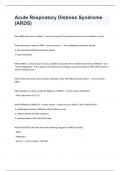
-
Acute Respiratory Distress Syndrome (ARDS) fully solved
- Examen • 8 páginas • 2024
-
Disponible en paquete
-
- 12,46 €
- + aprende más y mejor
Acute Respiratory Distress Syndrome (ARDS)Does ARDS only occur in adults? - correct answer No, it has been found to occur in children as well Three alternative names of ARDS - correct answer 1. *non-cardiogenic pulmonary edema* 2. increased-permeability pulmonary edema 3. acute lung injury Define ARDS - correct answer an acute condition characterized by *bilateral pulmonary infiltrates* and *severe hypoxemia* in the absence of evidence for cardiogenic pulmonary edema (CHF) within hours t...
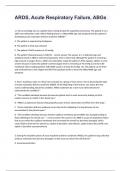
-
ARDS, Acute Respiratory Failure, ABGs questions with answers graded A+
- Examen • 14 páginas • 2024
-
Disponible en paquete
-
- 17,25 €
- + aprende más y mejor
ARDS, Acute Respiratory Failure, ABGs1.) You're providing care to a patient who is being treated for aspiration pneumonia. The patient is on a 100% non-rebreather mask. Which finding below is a HALLMARK sign and symptom that the patient is developing acute respiratory distress syndrome (ARDS)?* A. The patient is experiencing bradypnea. B. The patient is tired and confused. C. The patient's PaO2 remains at 45 mmHg. D. The patient's blood pressure is 180/96. - correct answer The answer is C...
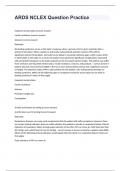
-
ARDS NCLEX Question Practice well answered 2024
- Examen • 8 páginas • 2024
-
Disponible en paquete
-
- 12,46 €
- + aprende más y mejor
ARDS NCLEX Question PracticeImpaired mental status (correct answer) Insulin resistance (correct answer) Seizures (correct answer) Rationale: Re-feeding syndrome occurs as the body's response when a person is fed or given nutrients after a period of starvation. When a patient is extremely malnourished and then receives TPN with its significant nutrient formulation, the body has to adjust to receiving nutrients again, which causes shifts in electrolytes in the body. As a result, the patient m...
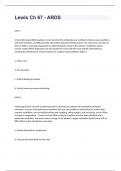
-
Lewis Ch 67 - ARDS verified already passed 2024
- Examen • 14 páginas • 2024
-
Disponible en paquete
-
- 14,38 €
- + aprende más y mejor
Lewis Ch 67 - ARDS ANS: C Arterial blood gas (ABG) analysis is most useful in this setting because ventilatory failure causes problems with CO2 retention, and ABGs provide information about the PaCO2 and pH. The other tests may also be done to help in assessing oxygenation or determining the cause of the patient's ventilatory failure. - correct answer Which diagnostic test will provide the nurse with the most specific information to evaluate the effectiveness of interventions for a patient...
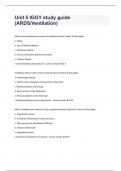
-
Unit 5 IGGY study guide (ARDS/Ventilation) correctly answered 2024
- Examen • 14 páginas • 2024
-
Disponible en paquete
-
- 17,25 €
- + aprende más y mejor
Unit 5 IGGY study guide (ARDS/Ventilation)Which are extrapulmonary causes of ventilatory failure? Select all that apply a. Stroke b. Use of opioid analgesics c. Pulmonary edema d. Chronic obstructive pulmonary disease e. Massive Obesity f. Increased intracranial pressure - correct answer A,B,E,F Ventilatory failure is the result of what processes? Select all that apply a. Hematologic disease b. Defect in the respiratory control center of the brain c. Physical problem of the lungs d....

¿Estrés por los estudios? Para los vendedores en Stuvia, estos son tiempos de oro. ¡KA-CHING! Gana también con tus resúmenes y empieza a subirlos ya. Descubre todo sobre cómo ganar en Stuvia


